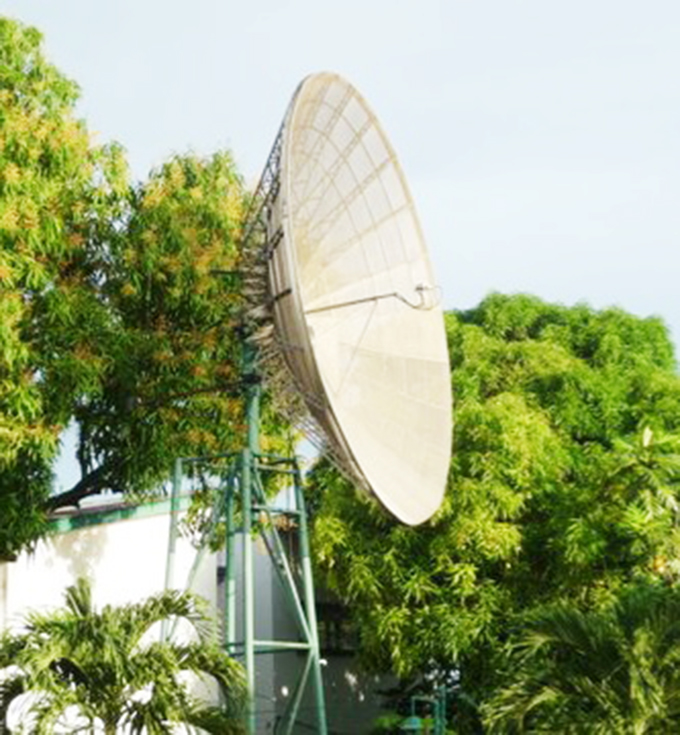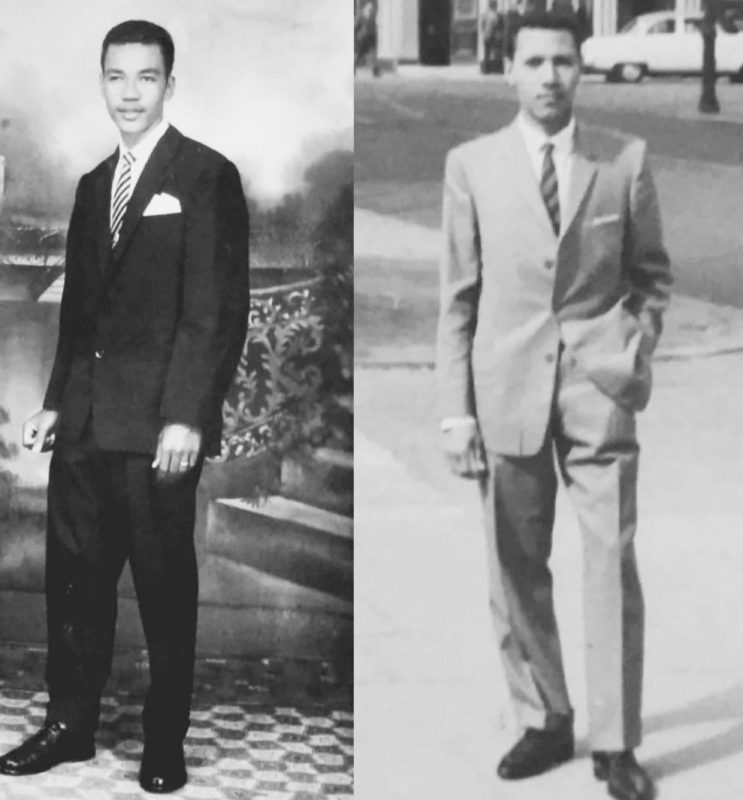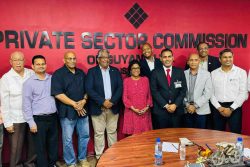As a professional, civil engineer Egbert ‘Bert’ Carter could have migrated as so many others have done but he chose to remain in Guyana to contribute to its development, and the many projects he undertook are today testimony to his work in spite of the discrimination he faced because of his political affiliation.
“I was discriminated against but that never stopped me because I have made my contribution to this country. I always found a way to voice my concerns and I hope I will never stop. Because I voiced my concerns I was targeted,” he said.
Born at Leeds (Number 50 Village) on the Corentyne Coast, Berbice in 1943, Carter celebrated his 80th birthday on April 23. Twenty-one family members and friends travelled to Guyana to mark the occasion with him.
He began to travel the country from an early age because his father was a fireman, who at one time worked at the fire station at the then Atkinson airbase, Timehri during World War II. “He worked with the Americans,” Carter recalled.
From the airbase, the family moved to Grove, East Bank Demerara where he spent most of his early childhood days. They then moved to McDoom in 1951 before taking up residence in Church Street, Georgetown next to the National Library. “It was the building immediately after the library. The building was owned by Dr Quail,” he reminisced.
“I walked over to the library anytime I wanted to and I think that is why I became such an avid reader and still read as much. When I misbehaved and was scolded I would go to the library where it was quiet and read. Only myself and my youngest sister went to the library to read very often.”
Carter is the second of six siblings of whom four were boys; two became civil engineers.
The father of two children, he was married for over four decades.
In Georgetown, he attended Central High School where he wrote the College of Preceptors and General Certificate of Education (GCE) Ordinary Level examinations. He did not write the GCE Advanced Level exams because Central High did not offer them. “You had to go to Queen’s College or Bishops High School to do A-Levels and not doing them was something I later regretted,” he said.
After completing his secondary education at Central High in 1960, he left British Guiana for England in 1961 to pursue studies in engineering.
“In the early 1960s, everyone was migrating to the United States or England. For the US you needed a visa; for England you didn’t need one. We were a British colony at the time,” he noted.
Not having A-Levels, he had to attend Hackney Technical College, East London to obtain an Ordinary National Certificate in Mechanical Engineering to gain entry to Regent Street Polytechnic (now the University of Westminster) which he attended from 1964 to 1967.
“At the time that was the place to be for civil engineering. I worked and studied. My older brother, who still lives in England, had been there for three months before me and he was hustling as well. We depended on each other. As it turned out I lived in the attic and he was in the basement of the building where we rented,” he recalled.
After graduating, Carter applied to 26 companies for a job and they all turned him down.
“That told me to return to university and do a postgraduate degree. So I went to Birmingham University and did a postgraduate degree in Highway and Traffic Engineering. I am the only qualified traffic engineer in Guyana up till now.” He noted there was another traffic engineer who held a PhD but he died about 10 years ago.
He returned to Guyana in 1969. “I couldn’t get a job. I returned to Guyana with a suitcase and £9, £1 more than when I left Guyana to go to England eight years before.”
Carter gained employment with the Mayor and City Council as an assistant city engineer, a post he held until 1973 when his contract ended.
“My tenure at that time was very interesting actually,” he recalled. “I put in the double arm columns in Water and Church streets for Christmas, 1969; also the skating rink at the Merriman Mall and traffic channelisation intersection at Camp Street and North Road. Traffic lights were introduced in this country in 1950 by a company out of Guyana by the Jardim family.”
The Cheddi Jagan Lecture Theatre, a three-storey building, designed and built in 2003 at a cost of $55 million in memory of the late Dr Cheddi Jagan who was instrumental in establishing the university in September 1963, is another of Carter’s designs and construction.
“Though the government of the day never gave me a job, I stayed in Guyana and faced the music. I had applied for the position of City Engineer when the City Engineer was retiring but I wasn’t considered. They said my application was late even though I took it in by hand,” he said.
When he left the M&CC he was offered employment at the then Guyana Electricity Corporation but turned it down because the emolument was no different from what the M&CC paid. Instead, he joined Guyana Refrigerators Limited (GRL). In 1980, GRL founded the company IDEAL that made solar water heaters, gas cookers and other products.
“I worked with GRL/IDEAL for 21 years. I designed the building for the GRL. I went up to England to purchase the machinery and equipment to be used for refrigeration. After the government changed in 1992, the GRL went by the wayside.” Carter retired in 1994.
He had installed the first locally-made working satellite antenna for television in Guyana at the then GTV. “That was how people saw the BBC on television in this country for the first time,” he noted.
In 1995 he worked with Eddie Vieira at Houston with Vieira Investments to operate a floating dry dock. It was the only one in the country. In 1995 and in 2001, he was responsible for changing the pontoons under the Demerara Harbour Bridge. In 2007, he was appointed a member of the Board of Directors of the Berbice River bridge. Carter has served on the boards several private and state-owned entities including Demerara Distillers Limited and Guyana Water Inc.
Post-mortem jobs
Carter said he got “a lot of post-mortem jobs” with the People’s Progressive Party/Civic administration. “I had to investigate the failure of the Conservancy Dam that caused the flooding on the East Coast Demerara in 2005; investigate why the stelling at Supenaam which was supposed to accommodate a roll-on-roll-off ferry, was not working properly at the time. You would recall when the ramp was put down, a truck rolled off the ferry into the river. That was done during the PPP administration.
“I had to investigate and make recommendations to improve the conditions on a number of projects including the East Demerara Water Conservancy. The excessive amount of rainfall we had in 2005 caused the dam to overflow. We accepted that the excess water from the Conservancy go to the Hope Canal. I feel confident that is the solution because since then we have had no flooding and we have had a lot of rain since then.”
The Mon Repos dam failed because it was built over an old koker outlet.
Once, former prime minister Sam Hinds met Carter and asked what he was doing and he replied, “Post-mortem work. We had a good laugh.”
Volunteering
For a year after he retired he did voluntary work around the country. “I felt I owed it to my country,” he said.
Among the volunteer work, he is particularly proud of designing and building a new structure to house the Guyana Society for the Prevention and Cruelty to Animals. “Dr Steve Surujbally, a good friend, asked me to help him dismantle the old building and put up a new one. We didn’t have enough money during the project and we were short of about $6 million. After brainstorming, Dr Surujbally suggested asking Mrs Janet Jagan for assistance. We asked and she gave the $6 million to complete the building. The design and architecture was mine.”
Another voluntary project was the extension to the National Library in 2000. “I was a member of the Interim Management Committee (IMC) as ‘a citizen of worth’ under then chairman Dr James Rose. The IMC ran the city for most of 1994. I was a member of the technical committee. At one time I was in charge of the maintenance of all the public libraries in Guyana including those in Georgetown, New Amsterdam, Linden and Essequibo. I had that affinity with the library and I was very close to the people in the library.”
Carter was also part of the engineering crew that volunteered to renovate the historical St George’s Cathedral. “I knew the cathedral needed to be rehabilitated. I joined the group that included Carlton Joao, Marcel Gaskin and other engineers. We put our heads together and completed the tasks we set ourselves. There is still some work to be done on the roof. The roof sheeting needs to be changed.”
Asked if he was a member of the Anglican Church, he said, “I am Anglican but it doesn’t matter which religion you are from. If you want to do something to help you will do it. That is a national monument.”
A lover of theatre arts, Carter volunteered his services to renovate the Theatre Guild in time for Carifesta X held here in 2008 at the encouragement of Major General Joe Singh (ret’d) and David de Caires who were trustees of Theatre Guild.
“I did a complete overhaul of the balcony which is named after me, the Bert Carter Balcony. I am a lover of the theatre. When I was in England I visited the theatres. When I was in New York I saw a few productions including the Phantom of the Opera, Color Purple and Lion King. In Guyana I enjoy going to shows at Theatre Guild.”
Also as part of his volunteerism, he worked with de Caires to rebuild Camp Street Avenue.
As a member of the National Trust, Carter noted, “I did a lot of voluntary rehabilitation work.” Among them were the Seven Ponds in the Botanical Gardens, Independence Park, the British War Museum, and Fort Island with the Court of Policy.
The work on the Court of Policy included recovery and rehabilitation. “We had to wade through mud to build the walkway to the building. We had to rehabilitate the building.”
In 2011, Carter was awarded the Medal of Service.
Walter Rodney
“The one I am proudest of is the monument to Walter Rodney in Hadfield Street, between John Street and Austin Place. Dr Maurice Odle and I financed that project.”
Carter was a supporter of Rodney. “I think that influenced my decision to return home. I knew Walter Rodney when he was at QC and I was living in Robb Street. When he moved to England, I introduced him to the Pan African Congress Platform in London in 1964 when he had gone up to do his PhD. We were very close friends. I think his death was totally unnecessary. “
Because of his affiliation with Rodney and the party he formed, the Working People’s Alliance, a number of obstacles were placed in Carter’s way to prevent him from voting in general and regional elections.
“It was either my name was not on the voters’ list or I was told I had already voted. In 1992, I became a presiding officer and ensured that I voted for the first time in Guyana. I was 49 years old when I first voted. The most ridiculous was in 1985 when I went to vote and was told that my name wasn’t on the voters’ list and I was asked to stand aside. Finally, the polling clerk called me and suggested that I vote for another person she didn’t think was going to come to vote. I said, ‘Hell! No!’ I left.”
City flooding
Asked if he ever made recommendations about the flooding in the city, Carter said he made several. He noted the filling in of several canals in the city like Main Street, Carmichael Street, Waterloo Street and Camp Street, Thomas Street, East Street with no alternative drainage, which adds to the quick flooding the city now experiences regularly.
He has recommended concretizing the drainage of North Road and Church and Lamaha streets. Canals would also allow for the more efficient operation of the channels. This would reduce costs of excavating the canals and enable street parking by utilising the parapet which could be done up to accommodate parking
Excavating the canals every two mornings or digging them deeper, he said, compromises the integrity of the roads.
“If you build the concrete channels and cover them over with concrete, you would not only provide parking but it would also be aesthetic and functional. “Right now parking is an issue.” The concrete channels between the Law Courts and the National Library were built before 1909 and they are still there. All the channels on Water Street were concretized since the early 1900s and are still functioning.
Apart from studying abroad, Carter has not lived outside of Guyana, but he has done work for a Guyanese company in St Lucia and renovated a friend’s building in Trinidad and Tobago.
“I don’t plan to live elsewhere either. I have lived in Guyana in spite of all the political upheavals when I could have migrated like so many other professionals. I believe as a citizen of my country I should help to build it,” he said.










